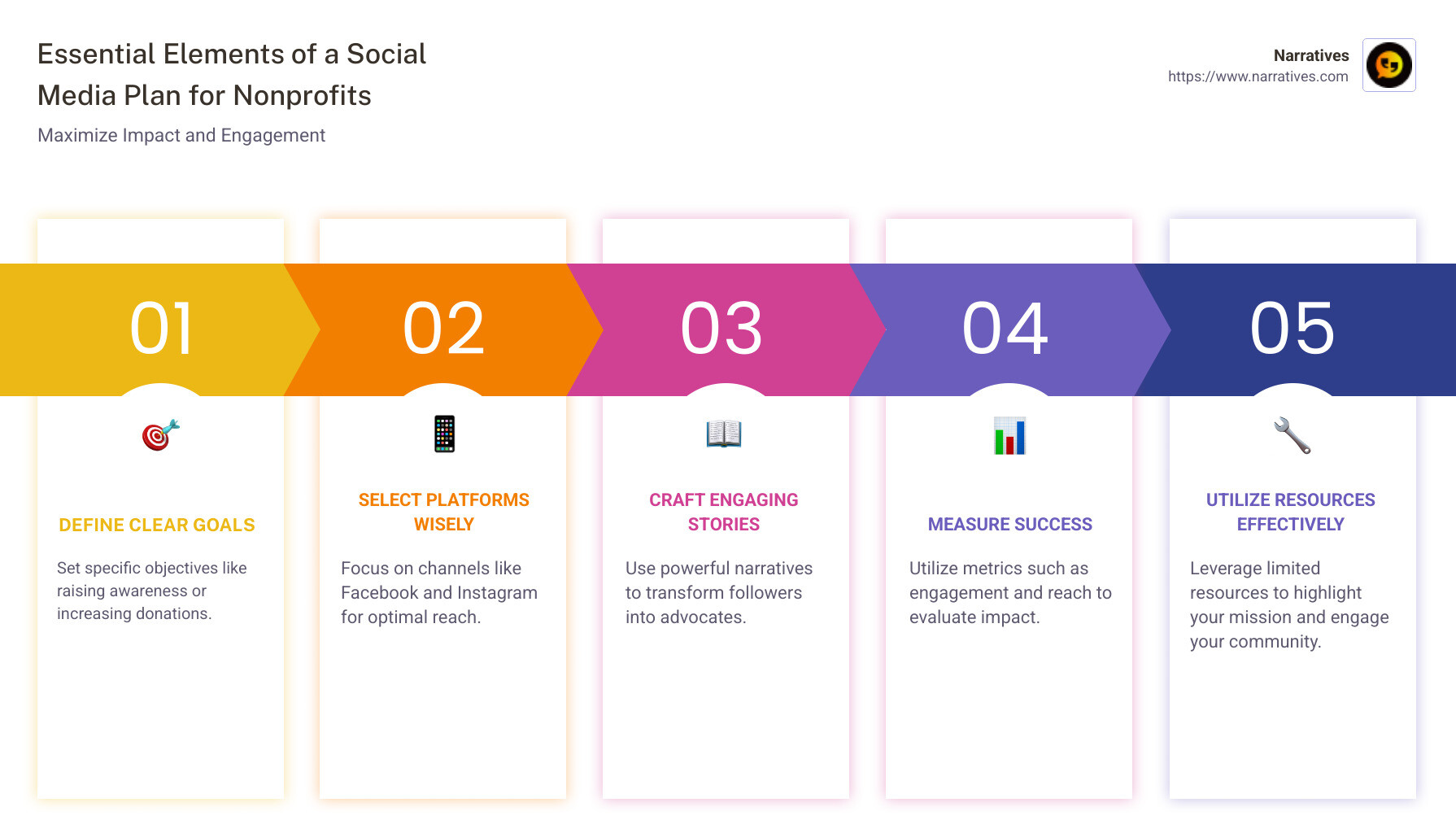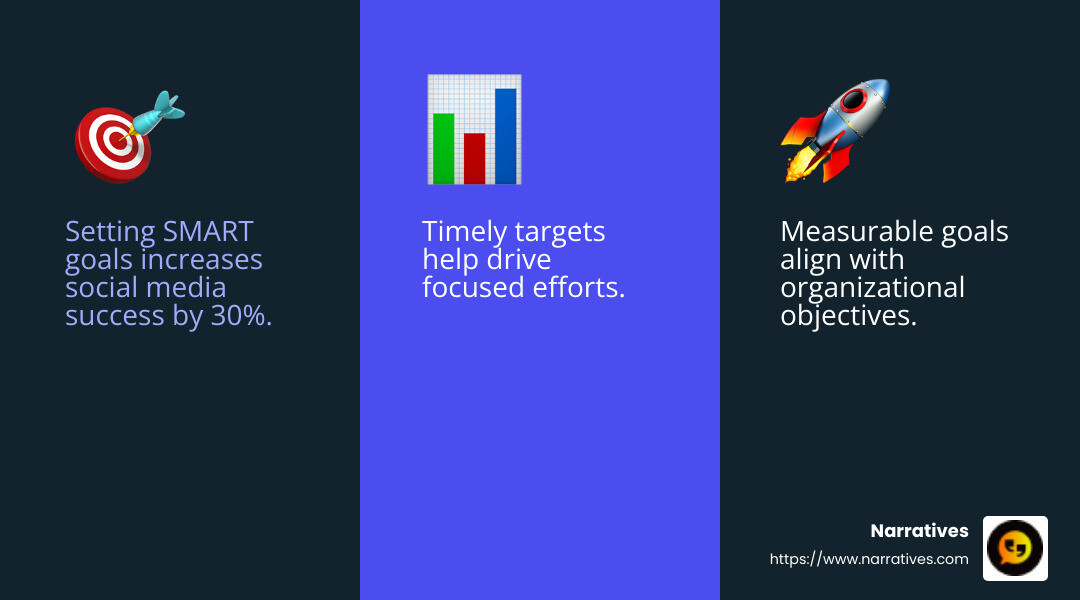Planning for Impact: Social Media Strategies for Nonprofits

A social media plan for nonprofits is crucial for amplifying impact and reaching audiences effectively. Social media isn't just a platform for sharing news; it's a space where nonprofits can build relationships, increase donations, and tell their stories in powerful ways.
- Nonprofits need a clear social media strategy: Define goals like increasing awareness or driving donations.
- Choosing the right platforms: Focus resources on one or two key channels to engage effectively.
- Engaging storytelling: Crafting stories that resonate can turn followers into advocates.
- Measure success: Track metrics like engagement and reach to understand impact.
Social media is a vital tool for nonprofit success. Engaging content and a strategic approach can highlight your mission and build a supportive community, even with limited resources.

Quick look at social media plan for nonprofits:
Setting Goals for Your Social Media Plan
When crafting a social media plan for nonprofits, setting clear goals is essential. These goals should align with your organization's broader objectives and help boost brand recognition. Let's break down how to set effective, actionable goals.
Organizational Objectives
First, identify what your nonprofit aims to achieve. Are you focusing on raising awareness, increasing donations, or building a volunteer base? Your social media goals should directly support these objectives. For instance, if your organization aims to increase community engagement, your social media goal could be to boost interaction rates on your posts by 20% over the next six months.
Social Media Goals
To create meaningful social media goals, consider using the SMART framework:
- Specific: Clearly define what you want to achieve. For example, instead of saying "raise awareness," specify "increase the number of post shares by 30%."
- Measurable: Use metrics to track progress. This could be the number of new followers, shares, or website clicks.
- Attainable: Set realistic goals that match your resources. If you're a small team, aim for manageable targets.
- Relevant: Ensure your goals align with your mission. If your focus is education, prioritize content that informs.
- Timely: Set a deadline. For example, aim to achieve your goal by the end of the quarter.
Brand Recognition
Building brand recognition through social media is about more than just posting frequently. It's about creating a consistent and authentic voice that resonates with your audience. Use visual content like photos and infographics to make your posts more engaging.
Case Study: The World Wildlife Fund successfully uses animal imagery to engage their audience, reinforcing why people follow them.
In summary, setting strategic goals for your social media efforts is crucial for nonprofit success. By aligning these goals with your organizational objectives and focusing on brand recognition, you can create a powerful social media presence that amplifies your mission.
Next, we'll explore how to identify and understand your audience to ensure your content resonates with the right people.
Identifying and Understanding Your Audience
Before you dive into crafting content, know who you're speaking to. Understanding your core audience is the backbone of a successful social media plan for nonprofits. Let's break down how to identify and connect with your audience effectively.
Core Audience
Your core audience consists of the people who are most likely to support your mission. They might be current donors, volunteers, or community members who are passionate about your cause. Understanding this group helps tailor your messaging to resonate with them.
Tip: Look at your current supporters. What do they have in common? This could be age, interests, or geographic location.
Personas
Creating personas can help you visualize and understand your audience better. Think of personas as fictional characters that represent your ideal supporters.
Example: Meet "Angela Activist," a 25-year-old who loves engaging in online petitions and social justice causes. She's likely to share news articles and participate in discussions. On the other hand, "Penelope Programs" is in her 40s, focuses on local community efforts, and values heartwarming stories and volunteer updates.
By crafting these personas, you can better tailor your content to meet the needs and interests of different segments of your audience.
Demographic Details
Demographics give you concrete data about your audience. This includes age, location, gender, education, and more. Most social media platforms offer analytics tools to help you gather this information.
Quick Stats:
- Age: Are you reaching more millennials or baby boomers?
- Location: Is your audience local, national, or international?
- Interests: What topics do they engage with most?
Knowing these details helps you decide which platforms to focus on and what type of content to create. For instance, if your audience is younger, TikTok might be a great platform to explore.
By identifying and understanding your audience, you ensure that your social media efforts are not just reaching people but reaching the right people. Up next, we'll discuss how to choose the right platforms to connect with your audience effectively.
Choosing the Right Platforms
Choosing the right platforms is a crucial step in crafting an effective social media plan for nonprofits. Each platform has its own strengths and audience, so knowing which ones align with your goals can make a big difference. Let's explore some popular platforms and how nonprofits can best use them.
Facebook is a powerhouse for nonprofits. With roughly 3 billion users, it offers a wide reach across various age groups. It's ideal for sharing event information, creating fundraising pages, and engaging with a community through comments and discussions.
Key Features:
- Event Promotion: Use Facebook Events to invite followers to fundraisers or community activities.
- Fundraising Tools: Registered nonprofits can add donation buttons to posts and live streams.
- Community Building: Engage with followers through comments and Facebook Groups.
Tip: Use Facebook's live-streaming feature to give followers a behind-the-scenes look at your organization.
Instagram is perfect for visual storytelling. If your nonprofit has a lot of compelling images or videos, this platform can amplify your message.
Key Features:
- Stories and Reels: Share quick, engaging content that highlights your mission and impact.
- Donation Stickers: Add these to Stories to make it easy for followers to donate directly through the app.
- Hashtags: Use relevant hashtags to increase the visibility of your posts.
Example: The American Red Cross uses Instagram Stories to provide updates on disaster relief efforts.
Twitter (X)
Twitter, now known as X, is great for quick updates and engaging in real-time conversations. Its character limit encourages concise messaging, which can be a powerful tool for nonprofits.
Key Features:
- Hashtag Campaigns: Create and promote hashtags to increase awareness and engagement.
- Media Interaction: Connect with journalists and media outlets to amplify your cause.
- Real-Time Updates: Share live updates from events or ongoing projects.
Tip: Use Twitter Polls to engage your audience and gather feedback.
Platform-Specific Strategies
Choosing the right platform also means tailoring your strategy to fit the platform's unique features and audience. Here's how:
- Facebook: Focus on community engagement and storytelling through longer posts and videos.
- Instagram: Prioritize high-quality visuals and leverage Stories for time-sensitive updates.
- Twitter: Use it for quick, impactful messages and to join conversations around trending topics.
By understanding the strengths of each platform, nonprofits can effectively reach their audience and amplify their mission. Up next, we'll dive into creating a content strategy that resonates with your supporters.
Creating a Content Strategy
Creating a content strategy is all about telling your nonprofit's story in a way that resonates with your audience. Here's how you can do it effectively.
Content Curation
Content curation involves gathering and sharing relevant content from various sources. This keeps your audience engaged without overwhelming your team with the need to create everything from scratch.
Tips for Effective Content Curation:
- Stay Relevant: Share content that aligns with your mission and goals. This could be news articles, partner updates, or user-generated content.
- Use Tools: Tools like Feedly or Pocket can help you find and organize content to share.
- Engage with Comments: Encourage discussions by asking questions or prompting feedback on curated content.
Multimedia Content
Visual and multimedia content are essential for capturing attention and communicating your message quickly.
Types of Multimedia Content:
- Photos and Graphics: Use images to highlight your nonprofit's impact. Tools like Adobe Express can help create eye-catching graphics.
- Videos: Short videos or reels can tell a powerful story in a limited time. Consider using Instagram's gallery feature to share multiple videos in one post.
- Infographics: Simplify complex data into easy-to-understand visuals. Infographics are highly shareable and can boost engagement.
Example: The World Wildlife Fund uses stunning wildlife photography and videos to engage animal lovers and draw attention to conservation efforts.
Storytelling
At the heart of any great social media plan for nonprofits is storytelling. Sharing real stories about your mission and the people you help can create an emotional connection with your audience.
Storytelling Tips:
- Be Authentic: Share genuine stories that showcase both successes and challenges. Authenticity builds trust.
- Highlight Impact: Use stories to illustrate the real-world impact of donations and support. This can motivate followers to take action.
- Involve Your Audience: Encourage supporters to share their own stories related to your cause. User-generated content can be a powerful tool for engagement.
Quote: "55% of people who engage with causes via social media are inspired to take further action" (Source: Georgetown CSIC). This emphasizes the power of storytelling in driving engagement and support.
By focusing on content curation, multimedia content, and storytelling, your nonprofit can craft a compelling narrative that resonates with supporters and amplifies your mission. Next, we'll explore how to measure and analyze the return on investment (ROI) of your social media efforts.
Measuring and Analyzing Social Media ROI
To understand if your social media plan for nonprofits is working, you need to measure and analyze your return on investment (ROI). This involves looking at various engagement metrics and using tools like Facebook Analytics and Google Analytics.
Engagement Metrics
Engagement metrics show how people interact with your social media content. They help you see what's working and what needs improvement.
Key Engagement Metrics:
- Likes, Shares, and Comments: These show if your content is resonating with your audience.
- Click-Through Rate (CTR): Measures how often people click on your links.
- Video Views: Indicates if people are interested in your video content.
- Follower Growth: Tracks how your audience is expanding over time.
By tracking these metrics, you can adjust your content strategy to better engage your audience.
Facebook Analytics
Facebook Analytics offers detailed insights into your page's performance. It's a powerful tool for nonprofits to gauge their impact.
Features of Facebook Analytics:
- Audience Insights: Understand who your followers are, including demographics and interests.
- Engagement Rates: See how well your posts are performing in terms of likes, shares, and comments.
- Conversion Tracking: Measure how many people take action after engaging with your content (like making a donation).
Using Facebook Analytics helps you tailor your strategy to what your audience loves.
Google Analytics
Google Analytics is essential for tracking how social media drives traffic to your website.
Key Features of Google Analytics:
- Traffic Sources: Find which social media platforms bring the most visitors to your site.
- Behavior Flow: See how users steer through your site after arriving.
- Goal Tracking: Set up goals to measure specific actions, like newsletter sign-ups or donations.
By combining insights from both Facebook Analytics and Google Analytics, you can get a comprehensive view of your social media ROI.
Understanding and using these tools effectively will help your nonprofit make data-driven decisions, ensuring your social media efforts are as impactful as possible.
Next, we'll address some frequently asked questions about developing a successful social media strategy for nonprofits.
Frequently Asked Questions about Social Media Plans for Nonprofits
How do I set effective social media goals?
Setting effective social media goals is all about aligning them with your nonprofit's broader objectives. Use the SMART framework to ensure your goals are clear and achievable:
- Specific: Define exactly what you want to accomplish. For example, "Increase event attendance by 20% through social media promotions."
- Measurable: Include metrics to track your progress, like "gain 500 new followers."
- Attainable: Make sure your goals are realistic given your resources.
- Relevant: Align your goals with your mission. If your nonprofit focuses on community outreach, your goal might be to "increase community engagement posts by 30%."
- Timely: Set a deadline to achieve your goals, such as "within the next six months."
By setting SMART goals, you can create a social media plan for nonprofits that is both strategic and actionable.
What are the best platforms for nonprofit engagement?
Choosing the right platform depends on where your audience spends their time. Here's a quick guide to help you decide:
- Facebook: Great for reaching a broad audience and sharing detailed stories. Use its event and donation features to engage supporters.
- Instagram: Ideal for visual storytelling with photos and videos. Perfect for showcasing your nonprofit's impact through imagery.
- Twitter: Best for real-time updates and engaging in conversations. Use hashtags to join relevant discussions and increase visibility.
Each platform offers unique opportunities to connect with your audience. Focus your efforts on the platforms where your target audience is most active.
How can I measure the success of my social media efforts?
To determine the success of your social media plan for nonprofits, track key performance indicators (KPIs) that align with your goals:
- Engagement: Look at likes, shares, comments, and retweets to gauge interaction.
- Reach: Measure how many people your posts are reaching.
- Traffic: Use tools like Google Analytics to see how much website traffic is coming from social media.
- Conversions: Track actions like donations or event registrations that result from social media interactions.
By regularly reviewing these metrics, you can assess what's working and make data-driven adjustments to your strategy. This ensures your social media efforts are making the desired impact.
Next, we'll conclude with how Narratives supports nonprofits in creating community-driven storytelling for social impact.
Conclusion
Community-driven storytelling is more than just a buzzword—it's a powerful tool for nonprofits to create meaningful connections and drive social impact. At Narratives, we believe in the transformative power of stories to lift underrepresented voices and inspire action.
Nonprofits face the unique challenge of standing out in a crowded digital space. With our expertise in high-quality, emotionally resonant multimedia content, we help organizations craft compelling narratives that not only capture attention but also build trust and credibility. By focusing on the stories that matter most, we empower nonprofits to showcase their impact and foster a deeper connection with their audience.
Our approach goes beyond traditional storytelling. We emphasize the importance of authenticity and transparency, ensuring that each narrative reflects the true essence of the communities served. This not only improves brand recognition but also galvanizes support from donors and volunteers.
Moreover, Narratives is committed to helping nonprofits measure the success of their social media plan for nonprofits. By analyzing engagement metrics and feedback, we provide insights that allow organizations to refine their strategies and maximize their reach.
Partnering with Narratives means more than just creating content; it's about building a legacy of positive change. Together, we can harness the power of storytelling to make a lasting impact.
Ready to transform your nonprofit's storytelling? Find how Narratives can help you lift your mission and drive social impact.


